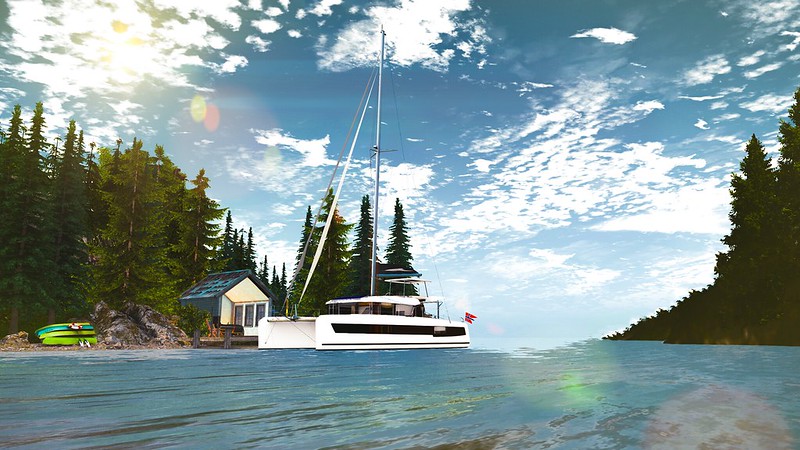(TNC member location, September Bay – photo by TNC Blogger Stina McGillivary)
We all know how powerful nature can be for our mental well-being. Whether it’s a walk through a sunlit forest or the simple act of sitting quietly by a stream, these moments connect us to something bigger and bring a sense of peace. But what happens when we can’t easily access these spaces? For many of us, nature isn’t always right outside our door. That’s where virtual nature spaces come in, offering an unexpected solution with tangible benefits.
What Are Virtual Nature Spaces?
Virtual nature spaces are immersive digital environments that recreate the look and feel of natural spaces—everything from serene forests to flowing rivers. Platforms like Second Life offer expansive and customizable virtual worlds where we can escape the hustle of daily life and surround ourselves with the beauty of nature, all from the comfort of home. While it’s not quite the same as stepping outside, virtual nature taps into our deep need for connection with the natural world, and it turns out there’s actual science backing up its benefits.
The Science Behind Virtual Nature
The impact of nature on our mental health has been studied for years, and it turns out that even virtual nature can provide similar benefits. Here’s a closer look at some of the science behind how these virtual spaces can improve mental well-being:
Stress Reduction
There’s a reason why so many people find nature so calming. Research shows that just viewing scenes of nature—whether they’re real or virtual—can lower cortisol levels, the hormone associated with stress. A study conducted by the University of Exeter found that participants who looked at natural environments had lower stress levels compared to those who didn’t. Virtual nature can offer a similar sense of calm, allowing us to reset and unwind, even if we can’t get outside.Attention Restoration
Attention Restoration Theory (ART) suggests that nature helps our brains recover from mental fatigue. Natural environments capture our attention in a gentle way, allowing us to relax and restore our cognitive focus. This theory applies not only to real-world nature but also to virtual environments, which mimic the same patterns and calming elements—like swaying trees or a flowing stream—that give our minds a much-needed break.Immersion and Mindfulness
One of the benefits of virtual nature is its ability to immerse us completely. When paired with virtual reality or explored through platforms like Second Life, virtual nature can transport us in a way that’s incredibly engaging. Studies have shown that VR nature experiences can evoke real feelings of calm, offering a brief escape from anxiety or stress. Even in non-VR settings, the ability to walk through a virtual forest or hear virtual birdsong creates a space for mindfulness, giving us a moment to pause and breathe.
The Mental Health Benefits of Virtual Nature
While nothing can fully replace the experience of being outdoors, virtual nature offers its own unique benefits that are backed by science. Some of these benefits include:
Mood Boost
We’ve all had those days where we just need a little lift. Virtual nature spaces are a perfect tool for that. Whether it’s a calming virtual forest or a meadow filled with flowers, these spaces have been shown to improve mood and create a sense of peace. For those of us who can’t always access real-life nature, virtual environments offer an accessible way to tap into those same positive feelings.Alleviating Anxiety and Depression
Nature therapy has long been used to help people manage symptoms of anxiety and depression, and virtual nature is a modern extension of that. The immersive calm of a virtual forest walk can reduce feelings of anxiousness, while the peaceful rhythms of a virtual ocean can provide a soothing environment for meditation or reflection. It’s a small escape that can have big benefits.Accessible Relaxation
One of the best things about virtual nature is its accessibility. Whether you live in a city, have limited mobility, or just need a quick mental escape, these spaces are there when you need them. Platforms like Second Life allow us to create our own little slice of nature, no matter where we are. You can explore a forest, walk along a beach, or find a quiet spot to sit under the stars—all without leaving home.
Real-Life Applications of Virtual Nature
Virtual nature isn’t just a niche idea—it’s already being used in therapeutic settings. Hospitals are incorporating virtual nature experiences to help patients manage pain and anxiety, and mental health professionals are using VR nature as part of treatment for anxiety and PTSD. These spaces offer a calming alternative to traditional therapies, making nature’s healing power accessible to more people than ever before.
We might not always have the ability to escape into nature, but virtual nature spaces are the next best thing. They bring the peace, calm, and restorative power of the outdoors right to our fingertips, offering a virtual sanctuary that’s just a click away. And while nothing beats the feeling of a cool breeze or the sound of real waves, these virtual spaces are more than just an escape—they’re a new tool for mental well-being. Whether you’re looking for a moment of calm in a busy day or just want to feel connected to nature again, virtual spaces, like those found in Second Life and in The Nature Collective, are a beautiful, science-backed way to find your balance.
“Nerdy for Nature” is a new blog segment by Emm Evergarden, founder of The Nature Collective SL, which highlights various nature topics and nature in the news. She hopes you enjoy all of her nerdy musings and carry the info that you might learn, within your day-to-day lives – doing your part to be a steward and caretaker of the Earth and all its inhabitants.

